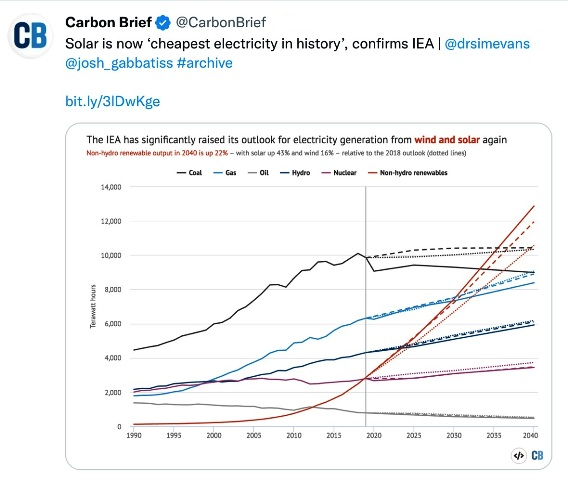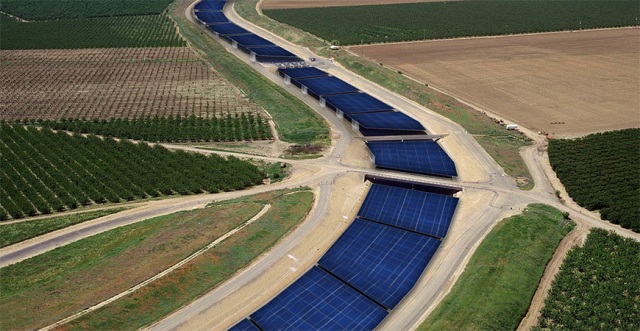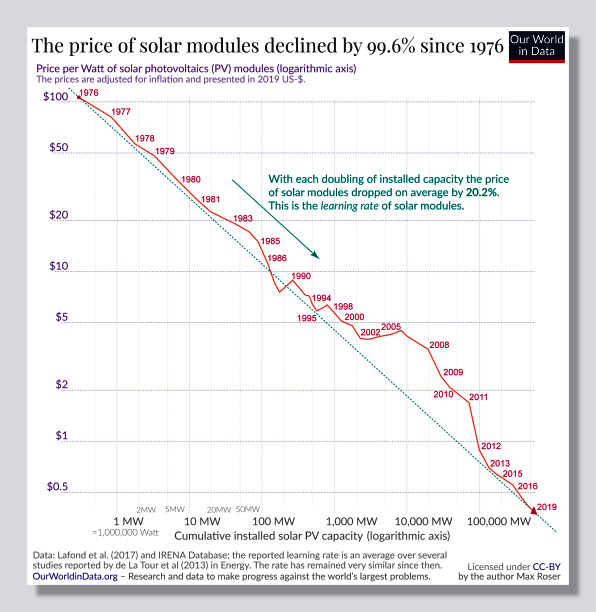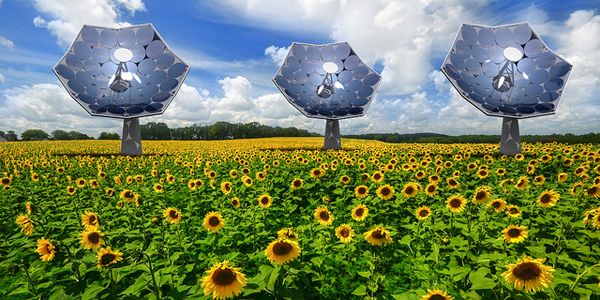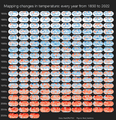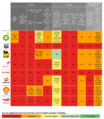Category:Solar Energy
<addthis />
Solar Power News
- Solar Power, Sun Powered
2023
Record-breaking solar-over-water production farm announced
2021
The world’s largest floating solar power and energy storage system is announced. At a cost estimated at $2 billion, the system will be developed by Singapore’s Sunseap Group in cooperation with Badan Pengusahaan Batam (BP Batam) operators of a free trade zone in Indonesia and installed at Batam Island.
Under an MOU between the two organizations, Sunseap will develop the floating photovoltaic system (FPV) and ESS energy storage system. The FPV is projected to have a capacity of 2.2 GWp and span around 1600 hectares, making it the largest FPV in the world to date. The ESS is also slated to be the largest ESS with a storage capacity of larger than 4000 MWhr. Construction is slated to begin in 2022 with a plan to be completed in 2024.
○
GreenPolicy360 says: solar-over-water production is a combo that will produce multiple benefits
We've discussed the new Over-Canal study with former Governor Jerry Brown -- the Solar-Over-Water plan is engineering meant for today's climate challenge
Solar panels over water canals and aqueducts could form a real power ticket in California -- and across the planet
Save water (lower water evaporation), create energy in ideal locations (a highest use for unused above-water space), provide worldwide potential for decarbonization to mitigate effects of climate change (with small- and large-scale solar production), construction can vary with modular design and construction lowering costs (solar-over-canals can act as highways for power delivery)
“The SolarAqua Grid model provides a combined, integrated response to addressing our water/energy nexus. It can help address California’s underlying vulnerabilities while meeting both state and federal level commitments to produce renewable energy, lower greenhouse gas emissions and mitigate climate change. Solutions such as these are not only viable but more urgently needed than ever before, particularly as the region returns to what many researchers refer to as a paleo-drought — a worst-case scenario for water managers.”
Significant evaporation savings, as much as 82% ... That amount of water can make a significant difference in water-short regions.”
The UC Solar AquaGrid study comes at a time when there is growing urgency for shifting from fossil fuels to renewable energy. UC engineers are rethinking how aging water and energy infrastructure can adapt to the challenges of sustainable water management, catastrophic wildfires, multi-day power outages and the American West’s "megadrought” — an ongoing stretch of extended dry conditions worse than any experienced since 1603, according to a recent report in the journal Science.
“Aqueducts are the arteries of our economic and social development, and have captured the public’s imagination for centuries,” said former State Water Board Chair Felicia Marcus. “A significant amount of our state’s electricity bill comes from moving, treating and heating water, so water efficiency is also energy efficiency. We need to find every way we can to use water more efficiently, including stemming evaporative loss, as we also scale up clean energy to meet the needs of the challenging century ahead under climate change.”
Energy and water co-benefits from covering canals with solar panels
SolarAqua Grid Study via Nature Sustainability
Solar power development over canals is an emerging response to the energy–water–food nexus that can result in multiple benefits for water and energy infrastructure. Case studies of over-canal solar photovoltaic arrays have demonstrated enhanced photovoltaic performance due to the cooler microclimate next to the canal. In addition, shade from the photovoltaic panels has been shown to mitigate evaporation and potentially mitigate aquatic weed growth. However, the evaporation savings and financial co-benefits have not been quantified across major canal systems. Here we use regional hydrologic and techno-economic simulations of solar photovoltaic panels covering California’s 6,350 km canal network, which is the world’s largest conveyance system and covers a wide range of climates, insolation rates and water costs. We find that over-canal solar could reduce annual evaporation by an average of 39 ± 12 thousand m3 per km of canal. Furthermore, the financial benefits from shading the canals outweigh the added costs of the cable-support structures required to span the canals. The net present value of over-canal solar exceeds conventional overground solar by 20–50%, challenging the convention of leaving canals uncovered and calling into question our understanding of the most economic locations for solar power.
··········································································································································
Keeping up with Solar Power
Via Forbes / May 2018
Solar Panels Life Cycle & Recycling
- Solar panels often contain lead, cadmium, and other toxic chemicals (e-waste) that cannot be removed without breaking apart the entire panel. For this reason, the whole solar panel is considered hazardous by many experts and governments.
- “Approximately 90% of most PV modules are made up of glass,” notes San Jose State environmental studies professor Dustin Mulvaney. “However, this glass often cannot be recycled as float glass due to impurities. Common problematic impurities in glass include plastics, lead, cadmium and antimony.”
- Researchers with the Electric Power Research Institute (EPRI) undertook a study for U.S. solar-owning utilities to plan for end-of-life and concluded that solar panel “disposal in “regular landfills [is] not recommended in case modules break and toxic materials leach into the soil” and so “disposal is potentially a major issue.”
IRENA Finding: “If fully injected back into the economy, the value of the recovered material [from used solar panels] could exceed USD 15 billion by 2050.”
- Perhaps the biggest problem with solar panel waste is that there is so much of it. All of that waste creates a large quantity of material to track, which in turn requires requires coordinated, overlapping, and different responses at the international, national, state, and local levels.
- The first step is a fee on solar panel purchases to make sure that the cost of safely removing, recycling or storing solar panel waste is internalized into the price of solar panels and not externalized... a 'decommissioning fund'.
- In July 2018, Washington became the first U.S. state to require manufacturers selling solar panels to have a plan to recycle.
- If the industry responds with foresight, it could end up sparking clean innovation including “developing PV modules without hazardous inputs and recycled rare metals." And that's something everyone can get powered up about.
··············································································
At the Forefront of Solar Energy: Manufacturing & Production in China
China reaches its solar energy installation target for 2020, reaffirming its position as largest producer of solar power on earth
China added 10.52 gigawatts (GW) of solar capacity to its national total over the course of July 2017, in addition to the 24.4 GW of capacity that was installed over the first six months of the year. The country is already the biggest producer of solar energy in the world, and that doesn’t seem likely to change any time soon.
In the last two months, China has added 24.02 GW of solar capacity. To put that into context, figures from earlier this year put Australia’s total capacity at around 6GW, a figure that’s projected to double by 2020. The US currently has a total capacity of 44.7 GW.
China has already cleared its goal of reaching a capacity of 105 GW by the end of 2020. The country has now attained 112.34 GW, and as such has tweaked its forecast for 2017, now predicting that this year’s installations will total between 40 and 45 GW when all is said and done.
·······················································································
The World Doubled Its Solar Power Capacity in 2016
○ ○ ○ ○ ○ ○ ○ ○ ○ ○ ○ ○ ○
Subcategories
This category has the following 9 subcategories, out of 9 total.
E
G
I
R
S
T
Pages in category "Solar Energy"
The following 111 pages are in this category, out of 111 total.
3
A
C
- California out in front in a Green future
- Campaign Finance System Reform
- Carbon Brief
- Climate Change - Global Warming Keyword-Terms
- Climate Change Denier Talking Points -- and Rebuttals
- Climate Change Summit Paris
- Climate Desk
- Climate Law Blog @Columbia Law School
- Climate migration
- Climate News
- Climate News Events Archive ... 1970 to Today
- Climate Plans Enforcement - Resources
- Climate Problems, Climate Solutions
- Cochin International Airport
D
E
- Each of us can make a positive difference
- Earth and Space, Politics
- Earth Day 2020
- Earth Day Memories on the 50th Anniversary
- Earth from NASA
- Earth Science
- Earth Science Eco-Fields
- Earth Science Research from Space
- Earth Science Vital Signs
- EarthTime
- EBikes 360
- Eco-nomics
- Election System Reform
- Energy Storage - Batteries and Grid
- Environmental full-cost accounting
- Environmental Protection Agency
- Environmental Rules Rolled Back
- ESA Living Planet Announcement - May 2022
- Ethics and Climate Change
- European Union Green Deal - Fit for 55
- EV Corridors Electric Vehicles Zero Emission Vehicles
- ExxonMobil and US House Science Committee v US Attorneys General and Environmental Groups
G
- Generation Green
- Glasgow Climate Summit - Pledges, Promises, Declarations - What's Next Up
- Global Climate Action Summit
- Global Risks Report
- Going Green
- Going Green: Texas v. Pennsylvania
- Green Bank in Maryland - and More
- Green Marketing
- Green New Deal
- Green Party
- Green Stories of the Day
- Green Stories of the Day - GreenPolicy360 Archive
- GreenPolicy360 Archive Highlights 2013
- GreenPolicy360 Archive Highlights 2014
- GreenPolicy360 Archive Highlights 2015
- GreenPolicy360 Archive Highlights 2016
- GreenPolicy360 Archive Highlights 2017
- GreenPolicy360 Archive Highlights 2018
- GreenPolicy360 Archive Highlights 2019
- GreenPolicy360 Archive Highlights 2020
- GreenPolicy360 Archive Highlights 2023
- GreenPolicy360 Highlights
- Growth of Photovoltaics
L
M
O
P
S
- San Francisco, CA Resolution Urging Nationwide Mobilization of Renewable Energy Resources
- Santa Anna, CA No Fee Solar Permits
- Sea-Level Rise
- Seattle University, WA Solar Power Project
- Solar Energy and Consumer Affairs
- Solar Power for Electric Vehicles
- Solar Power Plants in the Mojave Desert
- Solarsiedlung Solar Village
- Space Solar Energy
- Student Climate Strike-March 15, 2019
- Sunnyvale, CA Solar Heating Code
T
Media in category "Solar Energy"
The following 200 files are in this category, out of 722 total.
(previous page) (next page)- IEA News 1.jpg 480 × 400; 64 KB
- IEA News 2.jpg 480 × 475; 55 KB
- IEA News 3.jpg 480 × 496; 57 KB
- IEA News 4.jpg 480 × 530; 57 KB
- IEA News 5.jpg 480 × 539; 62 KB
- If.png 693 × 296; 494 KB
- Image3.png 196 × 30; 2 KB
- In Love with Earth.jpg 328 × 499; 15 KB
- India EV plan.png 485 × 468; 229 KB
- Infrastructure Bill and Climate Resilience - A Step Forward.png 640 × 403; 526 KB
- Investment in Power Capacity 2008-2015.png 697 × 326; 51 KB
- IPCC Report - Feb 2022.jpg 448 × 291; 113 KB
- IPCC report August 9-2021 (1).jpg 745 × 380; 156 KB
- IPCC report August 9-2021 (2).jpg 745 × 428; 171 KB
- ISS025E006291viaDougWheelock.jpg 3,246 × 1,937; 715 KB
- It's a good day for a sunflower pic.png 520 × 553; 0 bytes
- It's hot in South Florida - July 2023.jpg 480 × 537; 92 KB
- It's Hot the Times UK Says... Act Now or else - July 2022.png 800 × 416; 568 KB
- Ivanpah Solar1.jpg 800 × 527; 275 KB
- Jacinda - New Zealand.jpg 533 × 523; 64 KB
- January-May 2020 temp anomaly.jpg 680 × 380; 54 KB
- Jerry Brown AGU-Dec14,2016.png 476 × 344; 117 KB
- Jerry Brown re EPA - 19 June 2019.jpg 699 × 798; 126 KB
- Jerry Brown-Climate Week, NYC, Sept2018.jpg 800 × 534; 242 KB
- Jerry Brown-Global Climate Action Summit.png 800 × 453; 900 KB
- Jerry-Brown-quote.jpg 800 × 552; 69 KB
- Joan and Christiana - April 2022.png 486 × 460; 282 KB
- Joe Biden is projected winner Nov7-2020.jpg 343 × 120; 26 KB
- John Kerry - Climate Envoy - 2021-09-26.png 640 × 410; 349 KB
- Jorge Leon Arellano OPEC-Energy Demand Presentation-CSIS-Dec2016.png 700 × 394; 351 KB
- Journey of a Climate Pixel - May 2022.png 800 × 399; 114 KB
- July 14, 2018 - hello down there.png 524 × 467; 290 KB
- June 2019 - NASA GISS data - hottest on record.jpg 640 × 560; 58 KB
- Kamala Harris-GND-Jan 28,2019.png 679 × 609; 243 KB
- Katharine Hayhoe - Nov 26, 2019.jpg 508 × 466; 80 KB
- Keep going and going.png 354 × 184; 10 KB
- Kidscelebrateclimatelawsuit.jpg 480 × 319; 52 KB
- Kim Cobb - Georgia Tech professor of climate science.jpeg 800 × 533; 87 KB
- LA Times - July 2023 on the world's response to the climate crisis-1a.png 800 × 1,011; 657 KB
- LA Times on the world's response to the climate crisis-2.png 800 × 651; 297 KB
- LA Times on the world's response to the climate crisis-3.png 800 × 806; 302 KB
- LA Times on the world's response to the climate crisis-4.png 800 × 896; 321 KB
- Lamar accuses March 2017.png 800 × 439; 245 KB
- Lamar re science and Trumps truth.png 627 × 607; 206 KB
- Lamar Smith Denial Offensive.png 393 × 307; 224 KB
- Lamar's science.png 584 × 537; 204 KB
- LANDSAT - NASA.jpg 622 × 415; 95 KB
- Landsat 9 about to launch.png 420 × 721; 355 KB
- Landsat 9 Launches - 1.jpg 600 × 693; 128 KB
- Landsat 9 Launches - 2.jpg 600 × 737; 250 KB
- Landsat memories.png 535 × 473; 159 KB
- Landsat-Google Maps Screen Shot 2016-06-17 Columbia Glacier.jpg 1,200 × 587; 312 KB
- Launching soon.png 657 × 468; 225 KB
- LDCs face the climate crisis, raise the alarm - Nov 2021.png 419 × 226; 126 KB
- Leap Manifesto.png 700 × 153; 306 KB
- Like a speeding freight train.png 640 × 600; 492 KB
- Limits to Growth screenshot-30yr-40yr updates.png 448 × 329; 108 KB
- LMDCs make their case at the Glasgow climate summit.png 427 × 480; 259 KB
- Los-angeles timelapsedowntown m.jpg 794 × 496; 134 KB
- Los-angeles-smog-1970s.jpg 800 × 438; 19 KB
- M Channel Envisioning the Future 4.png 700 × 845; 246 KB
- Manchin again - July 15 2022.png 600 × 654; 523 KB
- Manchin kills the Biden climate plan.jpg 800 × 438; 71 KB
- Manchin News - Dec 20 2021.png 600 × 588; 307 KB
- Manchin News 2 - Dec 20 2021.png 600 × 600; 329 KB
- Mangroves regulate flooding - EDF.png 568 × 473; 328 KB
- Map of the World wiki commons GTN800x370.png 800 × 370; 39 KB
- Mapping changes in global temperature 1850-2022.png 656 × 680; 180 KB
- Mapping the Earth with Google Earth Outreach.jpg 640 × 648; 109 KB
- March for Science-1.png 800 × 291; 596 KB
- Mascot for Glasgow intl climate conference.jpg 575 × 396; 76 KB
- Mauna Loa CO2 - April 2022.png 600 × 618; 203 KB
- Mauna Loa CO2 week ending May 15, 2017.png 800 × 493; 77 KB
- Mauna Loa Observatory CO2 - April 2021 - New record high.jpg 656 × 600; 55 KB
- Maya Lin Ghost Forest 5-17-2021.jpg 618 × 454; 123 KB
- McKibben 350.org logo.jpg 300 × 170; 7 KB
- McKibben re Manchin - Dec 2021.png 370 × 368; 261 KB
- McKibben reaction to Manchin blocking Biden's climate plan.png 640 × 423; 140 KB
- Methane cuts pledge - COP27.png 399 × 336; 164 KB
- Methane emissions to be cut - COP26 pledges.png 640 × 464; 140 KB
- Methane Reduction proposal passes in EU Parliament - May 2023.png 620 × 600; 552 KB
- MethaneSat - 1.jpg 350 × 336; 58 KB
- MethaneSat - 2.PNG 448 × 336; 172 KB
- MethaneSat - 3.PNG 448 × 303; 248 KB
- Methods of Nonviolent Action.pdf ; 49 KB
- Methods to enforce climate pledges-NDCs - Dec 2021.png 539 × 480; 333 KB
- Miami Reminder.jpg 411 × 292; 52 KB
- Michael E Mann - July 2022.png 766 × 1,017; 671 KB
- Michael E Mann -- act with hope not fear.jpg 720 × 1,024; 122 KB
- Michael E Mann, act with hope not fear.jpg 1,246 × 1,772; 256 KB
- Michael Mann - Susan Joy Hassol after Glasgow.jpg 460 × 1,616; 299 KB
- Michael Mann, planet citizen.png 604 × 835; 273 KB
- Mick stands in support of the global climate strike.jpg 587 × 710; 123 KB
- Minerals used in clean energy technology - circa 2022.png 800 × 580; 197 KB
- MLT Geospace - the Edge.jpg 800 × 600; 22 KB
- Model 3 Elon TW.png 374 × 169; 39 KB
- Monitoring Greenhouse Gases from Satellite Missions 2021-2030.png 801 × 386; 143 KB
- Montana climate trial News - 2023-08-14.png 789 × 768; 389 KB
- Montreal Protocol - effects study 2021.jpg 640 × 401; 76 KB
- Moving to Higher Ground.png 568 × 473; 307 KB
- Mulvaney says no lifestyle change.jpg 561 × 779; 128 KB
- NASA and micro nano sats.png 443 × 431; 43 KB
- NASA Climate Feb16,2017.png 593 × 526; 348 KB
- NASA co2-graph-061219.jpg 800 × 500; 214 KB
- NASA EPIC DSCOVR - July 6 2015.png 768 × 956; 687 KB
- NASA has a new mission... against Methane.png 800 × 576; 681 KB
- NASA Launch of Landsat 9 - Sept 27, 2021.jpg 675 × 772; 131 KB
- NASA MODIS One week in April 2016.jpg 800 × 480; 87 KB
- NASA orbiting fleet 2015 m.jpg 690 × 518; 234 KB
- NASA Thermonuclear Art The Sun In Ultra HD 4K.gif 720 × 405; 26.97 MB
- NASA's continuing vision and mission - as of 2005.png 640 × 414; 153 KB
- National Climate Pledges Must Be Enforced.png 800 × 520; 122 KB
- National Climate Task Force - first mtg Feb 11 2021.jpg 591 × 654; 144 KB
- NDC Tracker - 2020.jpg 800 × 340; 50 KB
- Nelson, the oil spill and the student anti-war movement.png 600 × 457; 529 KB
- Net Zero 1.png 800 × 373; 368 KB
- Net Zero 2.png 800 × 255; 331 KB
- Net Zero Schools.png 640 × 83; 70 KB
- New Climate Maps for US - 2020.jpg 800 × 169; 34 KB
- New Climate Maps for US.jpg 677 × 405; 47 KB
- New Climate Model.jpg 777 × 412; 70 KB
- New German government announces far reaching climate plans.png 632 × 600; 446 KB
- New Mexico drought - climate change.png 538 × 480; 337 KB
- New Mexico Land Commissioner speaks up.png 497 × 405; 242 KB
- NextEra - January12 2021.jpg 530 × 127; 36 KB
- NIDIS Global Drought Conditions June 2016 Report .png 800 × 423; 214 KB
- Nikola Photo.jpg 620 × 333; 39 KB
- Nile River and Mideast.jpg 750 × 929; 87 KB
- NOAA - NCEI report on US temps 2023-2024.jpg 600 × 561; 109 KB
- NOAA Climate.Gov.png 589 × 99; 7 KB
- NOAA report on heat records broken in US - 2023.jpg 600 × 480; 229 KB
- NOAA undergoes political changes - Oct 2020.jpg 800 × 719; 135 KB
- Nobel Prize 2021.jpg 551 × 473; 212 KB
- North America West Coast hot - Aug 2023.png 484 × 501; 308 KB
- Nowhere is safe - The Guardian.jpg 467 × 566; 68 KB
- NYT - Nov 1 - Day 1 headlines from Glasgow Climate Summit.png 600 × 800; 103 KB
- Oceans hottest in 2022.png 800 × 501; 358 KB
- OCO-2 carbon dioxide Sept2014-Sept2015.gif 530 × 353; 677 KB
- Oct 21, 2021 - On Eve of International Climate Summit.jpg 733 × 466; 119 KB
- October 2016-400PPM.png 494 × 463; 160 KB
- Oil gas climate change response plans - circa 2022.png 729 × 837; 335 KB
- Oil profits and US gas prices.png 378 × 336; 163 KB
- On the road sjs.jpg 293 × 249; 0 bytes
- On-the-Road-11.jpg 800 × 326; 52 KB
- On-the-road-3.jpg 800 × 450; 107 KB
- One Sunflower at a Time.png 949 × 344; 810 KB
- One Year as the Earth Rolls.jpg 800 × 1,068; 66 KB
- Our Biggest Experiment - by Alice Bell.jpg 333 × 499; 40 KB
- Our Fragile Moment.jpg 612 × 480; 80 KB
- Our Fragile Moment.png 301 × 448; 360 KB
- Ovink 3a.jpg 800 × 600; 89 KB
- PACE - NASA Everything on Earth Is Connected.png 600 × 264; 70 KB
- PACE - NASA Jan 17 2024.png 600 × 662; 465 KB
- Paleoclimate-at the Museum of Natural History-2.png 800 × 449; 418 KB
- PBS NOVA on climate change resiliency.jpg 497 × 679; 122 KB
- Per capita CO2 emissions - to 2020.png 640 × 442; 153 KB
- Phytoplankton.jpg 600 × 600; 97 KB
- Picturing Earth from the International Space Station.jpg 800 × 470; 112 KB
- Piece of a Protoplanet.jpg 632 × 600; 69 KB
- Planet Citizen green energy.JPG 720 × 480; 99 KB
- Planet Dove satellite image over Dubai.png 800 × 791; 1.58 MB
- Planet home page-2022.png 800 × 400; 392 KB
- Planet of the Year Christo-Time.jpg 800 × 1,079; 175 KB
- Planet Plan B - for Senator Manchin.jpg 640 × 361; 89 KB
- PlanetCitizen - Your Moment on Earth.jpg 650 × 625; 80 KB
- PlanetCitizen banner.jpg 980 × 200; 31 KB
- Planetcitizens-336x336.png 336 × 336; 206 KB
- Politics and Science in the House un-Science Committee.png 619 × 352; 198 KB
- Pope meeting with oil execs - June 2019.png 640 × 360; 589 KB
- Poverty 2019.jpg 800 × 673; 91 KB
- Prodeco Phantom.png 640 × 373; 271 KB
- Production Gap - productiongap.org.png 600 × 762; 225 KB
- Production Gap - UN report on fossil fuel production.png 600 × 664; 342 KB
- Pruitt in the news daily.png 550 × 541; 148 KB
- Race to Zero - circa January 2022.png 480 × 591; 138 KB
- Race-to-Zero-US-Energy-Dept.jpg 575 × 800; 175 KB
- RacetoZero - Dec 2020 UNFCCC.jpg 585 × 518; 95 KB
- Recent Satellite Imagery of Earth - via Azavea.png 600 × 747; 488 KB
- Record tumble - climate change.png 727 × 333; 27 KB
- Red Line PPM.png 800 × 486; 163 KB
- Remembering E.O. Wilson and Thomas Lovejoy.jpg 640 × 327; 56 KB
- Renewable Energy investment growth chart 2004-2014.jpg 600 × 368; 31 KB
- Renewable Potential US-Utility Scale PV.png 660 × 514; 57 KB
- Renewables share of power generation 2000-2014.png 697 × 287; 61 KB
- Republican Party 2024 Climate Strategy.png 589 × 344; 44 KB
- Revkin - Dot Earth sign off Dec 5, 2016.png 648 × 687; 336 KB
- Revkin-Brown re AGU speech-Dec2016.png 494 × 343; 68 KB

